Method and apparatus for simultaneous lateral and vertical patterning of molecular organic films
a technology of molecular organic thin films and simultaneous lateral and vertical patterning, which is applied in the direction of applications, manufacturing tools, instruments, etc., can solve the problems of limited resolution, difficult to make large area shadow masks, and limited techniques, and achieves greater lift-off thickness and weaker intermolecular bonds
- Summary
- Abstract
- Description
- Claims
- Application Information
AI Technical Summary
Benefits of technology
Problems solved by technology
Method used
Image
Examples
experiment 1
Fabrication of OLEDs
[0057]Glass substrates are cleaned using a mixture of a cleaning solution and water, rinsed and sonicated with de-ionized water, acetone and boiling isopropanol and then treated with 5 minutes of oxygen plasma before spin coating. PEDOT:PSS was spin coated at 10° C. ramp and 3000 rpm for 30 seconds and subsequently baked for 10 minutes at 150° C. on a hotplate with glass dish cover. The samples were moved into a nitrogen glove box for organic deposition. Thermal evaporation of the organic layers occurred at pressures lower than 5×10−6 Torr, and deposition of organic layers ranged 1-5 A / s. The organic lift-off procedure was also performed in the nitrogen glove box on one of the two devices. After patterning, the device was completed by depositing the remaining organic layer and electrode cap of 50 nm Mg:Ag (10:1 weight ratio) / 50 nm Ag.
[0058]The PDMS stamp consists of a 10:1 weight ratio of base to curing agent from a Silicone Elastomer Kit. The mixture was stirred...
experiment 2
Fabrication of OLEDs
[0063]Several OLEDs were fabricated on ITO-coated glass substrates by first cleaning the substrate with sonication and then rinsing with de-ionized water, acetone, and boiling isopropanol. The substrates were treated by exposure to oxygen plasma for about five minutes. PEDOT:PSS was spin coated at 10° K. ramp and 3000 rpm for 30 seconds and subsequently baked for 10 minutes at 150° C. on a hotplate with glass dish cover. The samples were moved into a nitrogen glove box from where they were loaded into an integrated organic deposition vacuum chamber. A 50 nm thick TPD film and 20 nm thick TAZ film were thermally evaporated at base pressure of less than 5×10−6 Torr. Substrates were transferred back into the nitrogen-filled glove box where they were patterned using the stamp lift-off technique. Following the patterning step, the devices were coated with a 50 nm thick film of aluminum-tris-quinolate (Alq3), the electrode cap of 50 nm thick Mg:Ag (10:1 weight ratio) a...
experiment 3
Large Scale Fabrication
[0066]To evaluate suitability of the CLOP technique in fabrication of OLEDs, a set of OLEDs with blanket deposited organic films was compared to a set of OLEDs in which the lift-off patterning was applied to remove partial thickness of the hole transport layer. To avoid variation in the quality of the organic thin films, both devices were grown simultaneously on the same substrate.
[0067]FIG. 8A schematically illustrates the device patterned according to the disclosed embodiments. Namely, device 800 of FIG. 8 includes substrate 810, supporting ITO electrodes 820 and layer 830 which comprises PEDOT:PSS. TPD layer 840 had an initial thickness of about 100 nm. Using the disclosed patterning technique a portion of the TPD layer 840 has been patterned to form a via 20 nm deep. Layer 850 is Alq3 and is about 50 nm thick. The final structure has a common Mg:Ag cathode (layer 860) and independent ITO (layer 870) cathode. Other than the nm via, the base line device had ...
PUM
| Property | Measurement | Unit |
|---|---|---|
| Depth | aaaaa | aaaaa |
| Temperature | aaaaa | aaaaa |
| Pressure | aaaaa | aaaaa |
Abstract
Description
Claims
Application Information
 Login to View More
Login to View More - R&D
- Intellectual Property
- Life Sciences
- Materials
- Tech Scout
- Unparalleled Data Quality
- Higher Quality Content
- 60% Fewer Hallucinations
Browse by: Latest US Patents, China's latest patents, Technical Efficacy Thesaurus, Application Domain, Technology Topic, Popular Technical Reports.
© 2025 PatSnap. All rights reserved.Legal|Privacy policy|Modern Slavery Act Transparency Statement|Sitemap|About US| Contact US: help@patsnap.com



